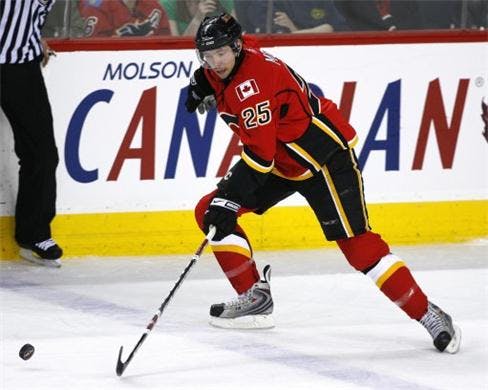Not a Lot of Change

When looking at the Calgary Flames roster as it appears right now, you’ll notice one thing that isn’t the most common in today’s NHL: a group of forwards that is virtually unchanged from the year prior. There will be slight changes from the coming training camp as opposed to one year ago, as Daymond Langkow will be present and Ales Kotalik will not. For the most part, however, it’s the same group, something that has it’s pros and cons. The Flames are leaning far heavier to the former as opposed to the latter.
When things were at their best for the Calgary Flames, the line combinations looked like this:
Alex Tanguay-Brendan Morrison-Jarome Iginla
Curtis Glencross-Olli Jokinen-David Moss
Niklas Hagman-Mikael Backlund-Rene Bourque
Tom Kostopoulos-Matt Stajan-Tim Jackman
Curtis Glencross-Olli Jokinen-David Moss
Niklas Hagman-Mikael Backlund-Rene Bourque
Tom Kostopoulos-Matt Stajan-Tim Jackman
So, the loss of Kotalik isn’t really all that significant, as he barely played on the big club last year while Langkow coming back was easy to fit in with injuries to Moss and Morrison at the end of the season. That said, all 12 of those forwards are back for the coming year, along with Langkow, on a team that missed the playoffs last season.
The Flames are certainly excited for the lack of large change during the summer, as the belief is it gives them a great chance to have continuity right off the hop, hopefully to avoid the early season swoon the team suffered last year. It’s one of the topics I’ve focused on during a number of off season interviews to this point.

"I think it’s great," said forward David Moss when I talked to him last week. "When you can come into camp and you know the guys, and for the most part you know the guys you’re playing with, you know they’re tendencies, you played together…for more than a couple years and I think that’s great. There’s no adjustment period and you should be able to go out and play and get the ball rolling right away."
It’s a good concept. Calgary had such issues getting out of their own way to start last season and it played a large part in why they were sitting near the bottom of the Western Conference for parts of November and December. In theory, having a group of guys familiar with each other could eliminate some of those growing pains and put the team in a good spot to start the season.
There’s also a desire to keep the group together. A group that went on a pretty remarkable run through January and February.
"I think it’s really important," GM Jay Feaster told me on Saturday. "It’s a tough thing to articulate, the kind of change that we saw in the room and the way this team came together and the way they really bought into the things that Brent (Sutter) wants to do in terms of system and style of play and I think it’s going to be great."
I can see the positive side of keeping this group together. However, there’s also a concerning side of it, when looking at next season by itself. Let’s remember, the Flames missed the playoffs last year, and did so with names like Jarome Iginla, Alex Tanguay, Curtis Glencross and David Moss having impressive statistical years. They also did it while Rene Bourque and Matt Stajan, among others, were generally terrible.
Seeing Bourque, Stajan, Hagman and other have bounce back seasons is not something I’m worried about. In fact, I think it’ll happen on most, if not all, fronts. What worries me more is knowing Iginla scored 43 goals last year and the team missed the playoffs, while Morrison and Tanguay both ahd huge rebound years themselves. Those contributions, especially from that trio, will have to be similar to what they were last year, as we don’t anticipate that line being used in a "best on best" role.
That job of working against top line players on the other team will likely fall to guys like Glencross, Moss, and perhaps Langkow, and they likely will all do a solid job, the same way they have prior in their career. However, being put in that role consistently also lessens their offensive contributions. It’s pretty simple: if you’re tasked with shutting down the best of the best on the other side, sometimes your own offensive numbers are going to suffer. We saw that in effect two seasons ago with the offensive numbers of Langkow.
So while some important players will be taking on very important roles, there’s a chance the Iginla line will be placed in more favourable spots to put up offensive numbers. But that means they’re going to have to do it. And it’s not like I’m saying they won’t. Another full season with another full training camp for the Tanguay-Iginla duo could very possibly result in another strong offensive season, and it would surprise no one if that came to pass. It was Iginla’s best offensive season in the last three years, and he turned 34 on Canada Day. Not being surprised seeing Jarome surpass 40 is one thing; expecting it, or relying on it, to happen is another thing.
For his part, Feaster believes another season with the same Head Coach is the way to go for this group of forwards. "To a man, the guys, I believe understand Brent," he said. "They saw, in my mind, Brent being himself and coaching the way he believes in that second half and to have that same group come back, I think it’s awesome."
For me, bringing back a largely unchanged team after a second straight non-playoff year is a risk. I will admit it has the potential to yield some nice results too, but it depends on a number of things coming to pass, and as we know there are no guarantees. However, as I’ve said many times, I look at the Flames as more than just the coming season. If this group doesn’t have overwhelming success this year, it doesn’t affect the long term direction of the club.
It’s not the way ownership or management will ever look at it, but I look at it this way: The long term future, starting with next summer, is what’s really important to the Calgary Flames. Some nice success this year, and maybe a postseason birth, is just icing on the cake.
Recent articles from Pat Steinberg




